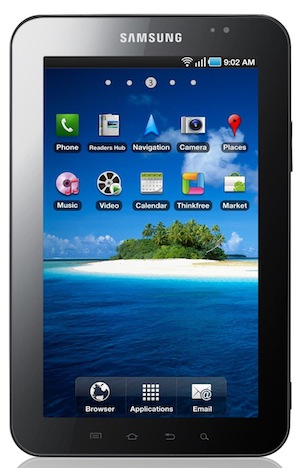 Gartner, Inc. announced it forecasts that worldwide media tablet sales will reach 19.5 million units in 2010.
Gartner, Inc. announced it forecasts that worldwide media tablet sales will reach 19.5 million units in 2010.
According to the statement, media tablets (Apple iPad, RIM PlayBook, Samsung Galaxy Tab, etc.) are poised for strong growth with worldwide sales projected to total 54.8 million units in 2011 (up 181% from 2010) and surpass 208 million units in 2014.
For more information visit: www.gartner.com
Unedited press release follows:
 Gartner Says Worldwide Media Tablet Sales on Pace to Reach 19.5 Million Units in 2010
Gartner Says Worldwide Media Tablet Sales on Pace to Reach 19.5 Million Units in 2010
Media Tablet Sales to Grow 181 Percent in 2011
STAMFORD, Conn., October 15, 2010 – Driven by sales of the iPad, worldwide media tablet sales to end users are forecast to reach 19.5 million units in 2010, according to Gartner, Inc. Media tablets are poised for strong growth with worldwide end user sales projected to total 54.8 million units in 2011, up 181 percent from 2010 (see Table 1), and surpass 208 million units in 2014.
Gartner analysts said the impact of media tablets on other devices will vary among segments.
“The all-in-one nature of media tablets will result in the cannibalization of other consumer electronics devices such as e-readers, gaming devices and media players,” said Carolina Milanesi, research vice president at Gartner. “Mini notebooks will suffer from the strongest cannibalization threat as media tablet average selling prices (ASPs) drop below $300 over the next 2 years.”
Low-end consumer notebooks will only marginally suffer from cannibalization. Gartner analysts expect very limited cannibalization on communication devices based on open OS (smartphones). The majority of the impact will be from 7-inch media tablets on high-end smartphones as it will be hard for a user to justify owning both when the differentiation in usage model is very limited. Users buying a 7-inch tablet might opt for a lower priced smartphone with a smaller form factor.
What’s a media tablet?
Media tablets are slate devices that support touch and run a lightweight OS such as iOS, Android, WebOS or Meego. Examples of media tablets are the Apple iPad, Samsung Galaxy Tab and the Cisco Cius.
Table 1
Worldwide Media Tablet Sales to End Users (Thousands of Units)
| 2010 Sales | 2011 Sales | 2012 Sales | 2013 Sales | |
| Media Tablets | 19,490 | 54,781 | 103,425 | 154,150 |
Source: Gartner (October 2010)
North America will account for 61 percent of media tablet sales in 2010. As these devices become available in more markets, North America’s share of media tablet sales will drop to 43 percent in 2014.
In 2010, celluar/Wi-Fi media tablets will account for 55 percent of sales, and by 2014, celluar/Wi-Fi media tablets will account for 80 percent of sales.
10-inch media tablets to play a role as companion devices in the enterprise market
In the enterprise space, for the immediate future, the main use of media tablets is as a notebook companion or as a secondary device to take on the road or use for fast access to e-mail, calendaring, interrogating Web applications and information sources, and showing PowerPoint presentations.
The majority of knowledge workers cannot use media tablets to replace their notebooks. Since these workers usually also have smartphones, media tablets become their third device. Most organizations will not buy that third device. Because of the convenience factor for travel and an “instant on” for quick look-up functions, many users are paying for the media tablets with their own money to use both for work and pleasure.
As media tablets move from early adopters to mainstream, media tablets will become a family purchase as well as a personal one. The touch user interface, the applications available on the different operating systems and the simpler set up compared to a full-fledged computer make media tablets ideal for a range of consumers: from power users to techno-phobics. As costs decrease, media tablets will be added to the list of the devices lying around the house that are shared by the family.
“Communication service providers (CSPs) who have so far subsidized mini-notebooks to drive mobile broadband uptake will shift their marketing spend to media tablets. Such subsidies will help drive adoption among those consumers who see the initial hardware cost as a hurdle,” Ms. Milanesi said. “For the rest, the freedom of paying for cellular only if and when needed, and not having to add another contract to the one a user might already have on his or her phone, is a great advantage and has so far proved successful for Apple.”
A detailed statistical outlook for media tablets is available in the Gartner report “Forecast: Connected Mobile Consumer Electronics, Worldwide, 2008-2014.” The report is available on Gartner’s website at http://www.gartner.com/resId=1451714.
Ms. Milanesi provides additional commentary in her blog post on the Gartner Blog Network at http://blogs.gartner.com/carolina-milanesi/2010/10/15/so-our-media-tablet-forecast-is-out-have-we-been-drinking-the-kool-aid/
About Gartner:
Gartner, Inc. (NYSE: IT) is the world’s leading information technology research and advisory company. Gartner deliver the technology-related insight necessary for its clients to make the right decisions, every day. From CIOs and senior IT leaders in corporations and government agencies, to business leaders in high-tech and telecom enterprises and professional services firms, to technology investors, Gartner is the indispensable partner to approximately 60,000 clients in 10,000 distinct organizations. Through the resources of Gartner Research, Gartner Executive Programs, Gartner Consulting and Gartner Events, Gartner works with every client to research, analyze and interpret the business of IT within the context of their individual role. Founded in 1979, Gartner is headquartered in Stamford, Connecticut, U.S.A., and has approximately 4,300 associates, including approximately 1,200 research analysts and consultants serving clients in 80 countries. For more information, visit www.gartner.com.